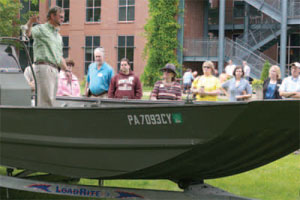Message from the President
This issue of Conserve is devoted to Western Pennsylvania’s rivers, streams and watersheds, and the Western Pennsylvania Conservancy’s programs and efforts to protect and restore them.

Guests listen to Eric Chapman, WPC’s director of aquatic science, at the Local Water Summit at WPC’s Pittsburgh office on Washington’s Landing.
Western Pennsylvania’s rivers and streams are among the defining attributes that make our region a special, magnificent place — whether we are thinking of our region’s principal city, or the flora and fauna our region supports, or the recreational opportunities our waterways provide. The city of Pittsburgh is defined physically by the confluence of two mighty rivers that combine into one. Our region’s biodiversity depends on healthy watersheds like French Creek or the Brokenstraw. And a hike in Western Pennsylvania is often highlighted by the experience of stumbling across a meandering stream or a rocky run.
The Western Pennsylvania Conservancy builds on a significant legacy of conservation work along rivers like the Clarion and Allegheny. With that legacy in place, the Conservancy began a focused approach to watershed work in 2001 by establishing our Watershed Conservation Program. Since that time, we have worked to protect or restore more than 1,000 stream miles, and worked with over 500 partner organizations in local watersheds. Our land conservation and watershed staffs work jointly to protect our streams and surrounding land in places like the Tubmill Creek watershed in Ligonier Valley.

It is appropriate that, when the United Nations selected Pittsburgh as the North American host city for the June 10, 2010 World Environment Day, its organizers chose themes of water and biodiversity, and convened the Water Matters! Global Water Conference to look at significant water issues. The Conservancy was pleased to take part in the conference and other World Environment Day activities, including hosting a member event to review progress and challenges in improving local waterways.
In this issue you will also see how Western Pennsylvania Conservancy projects — with the help of a broad range of partners and supporters — are contributing to healthy watersheds in Western Pennsylvania.
Cover photo taken by Greg Funka at McConnells Mill State Park.
Thomas Saunders

President
What will the next generation
inherit from you?
By including the Western Pennsylvania Conservancy in your estate plans, you will ensure that our natural heritage is also a part of your legacy.
